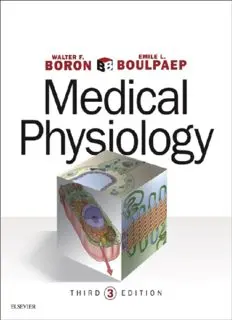
Medical Physiology PDF
Preview Medical Physiology
Medical Physiology THIRD EDITION WALTER F. BORON, MD, PhD Professor David N. and Inez Myers/Antonio Scarpa Chairman Department of Physiology and Biophysics Case Western Reserve University Cleveland, Ohio EMILE L. BOULPAEP, MD Professor Department of Cellular and Molecular Physiology Yale University School of Medicine New Haven, Connecticut Table of Contents Instructions for online access Cover image Title Page Copyright Contributors Video Table of Contents Preface to the Third Edition The eBook Acknowledgments Preface to the First Edition Target Audience Content of the Textbook Emphasis of the Textbook Creating the Textbook Special Features Acknowledgments Section I Introduction Chapter 1 Foundations of Physiology References Section II Physiology of Cells and Molecules Chapter 2 Functional Organization of the Cell Structure of Biological Membranes Function of Membrane Proteins Cellular Organelles and the Cytoskeleton Synthesis and Recycling of Membrane Proteins Specialized Cell Types References Chapter 3 Signal Transduction Mechanisms of Cellular Communication Receptors That are Ion Channels Receptors Coupled to G Proteins Receptors That are Catalytic Nuclear Receptors References Chapter 4 Regulation of Gene Expression From Genes to Proteins The Promoter and Regulatory Elements Transcription Factors Regulation of Inducible Gene Expression by Signal-Transduction Pathways Epigenetic Regulation of Gene Expression Post-Translational Regulation of Gene Expression References Glossary Chapter 5 Transport of Solutes and Water The Intracellular and Extracellular Fluids Solute Transport Across Cell Membranes Regulation of Intracellular Ion Concentrations Water Transport and the Regulation of Cell Volume Transport of Solutes and Water Across Epithelia References Chapter 6 Electrophysiology of the Cell Membrane Ionic Basis of Membrane Potentials Electrical Model of a Cell Membrane Molecular Physiology of Ion Channels References Chapter 7 Electrical Excitability and Action Potentials Mechanisms of Nerve and Muscle Action Potentials Physiology of Voltage-Gated Channels and Their Relatives Propagation of Action Potentials References Chapter 8 Synaptic Transmission and the Neuromuscular Junction Mechanisms of Synaptic Transmission Synaptic Transmission at the Neuromuscular Junction Toxins and Drugs Affecting Synaptic Transmission References Chapter 9 Cellular Physiology of Skeletal, Cardiac, and Smooth Muscle Skeletal Muscle Cardiac Muscle Smooth Muscle Diversity among Muscles References Section III The Nervous System Chapter 10 Organization of the Nervous System Cells of the Nervous System Development of Neurons and Glial Cells Subdivisions of the Nervous System References Chapter 11 The Neuronal Microenvironment Cerebrospinal Fluid Brain Extracellular Space The Blood-Brain Barrier Glial Cells References Chapter 12 Physiology of Neurons Signal Conduction in Dendrites Control of Spiking Patterns in the Soma Axonal Conduction References Chapter 13 Synaptic Transmission in the Nervous System Neuronal Synapses Neurotransmitter Systems of the Brain Fast Amino Acid–Mediated Synapses in the CNS Plasticity of Central Synapses References Chapter 14 The Autonomic Nervous System Organization of the Visceral Control System Synaptic Physiology of the Autonomic Nervous System Central Nervous System Control of the Viscera References Chapter 15 Sensory Transduction Chemoreception Visual Transduction Vestibular and Auditory Transduction: Hair Cells Somatic Sensory Receptors, Proprioception, and Pain References Chapter 16 Circuits of the Central Nervous System Elements of Neural Circuits Simple, Stereotyped Responses: Spinal Reflex Circuits Rhythmic Activity: Central Pattern Generators Spatial Representations: Sensory and Motor Maps in the Brain Temporal Representations: Time-Measuring Circuits References Section IV The Cardiovascular System Chapter 17 Organization of the Cardiovascular System Elements of the Cardiovascular System Hemodynamics How Blood Flows Origins of Pressure in the Circulation How to Measure Blood Pressure, Blood Flow, and Cardiac Volumes References Chapter 18 Blood Blood Composition Blood Viscosity Hemostasis and Fibrinolysis References Chapter 19 Arteries and Veins Arterial Distribution and Venous Collection Systems Elastic Properties of Blood Vessels References Chapter 20 The Microcirculation Capillary Exchange of Solutes Capillary Exchange of Water Lymphatics Regulation of the Microcirculation References Chapter 21 Cardiac Electrophysiology and the Electrocardiogram Electrophysiology of Cardiac Cells The Electrocardiogram Cardiac Arrhythmias References Chapter 22 The Heart as a Pump The Cardiac Cycle Cardiac Dynamics From Contractile Filaments to a Regulated Pump References Chapter 23 Regulation of Arterial Pressure and Cardiac Output Short-Term Regulation of Arterial Pressure Regulation of Cardiac Output Matching of Venous Return and Cardiac Output Intermediate- and Long-Term Control of the Circulation References Chapter 24 Special Circulations The Brain The Heart The Skeletal Muscle The Splanchnic Organs The Skin References Chapter 25 Integrated Control of the Cardiovascular System Interaction among the Different Cardiovascular Control Systems Response to Erect Posture Responses to Acute Emotional Stress Response to Exercise Response to Hemorrhage References Section V The Respiratory System Chapter 26 Organization of the Respiratory System Comparative Physiology of Respiration Organization of the Respiratory System in Humans Lung Volumes and Capacities References Chapter 27 Mechanics of Ventilation Static Properties of the Lung Dynamic Properties of the Lung References Chapter 28 Acid-Base Physiology pH and Buffers Acid-Base Chemistry When Is the Only Buffer Acid-Base Chemistry in the Presence of and Buffers—The Davenport Diagram pH Regulation of Intracellular Fluid
